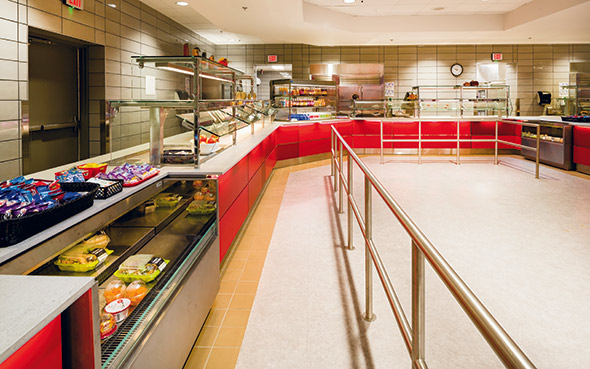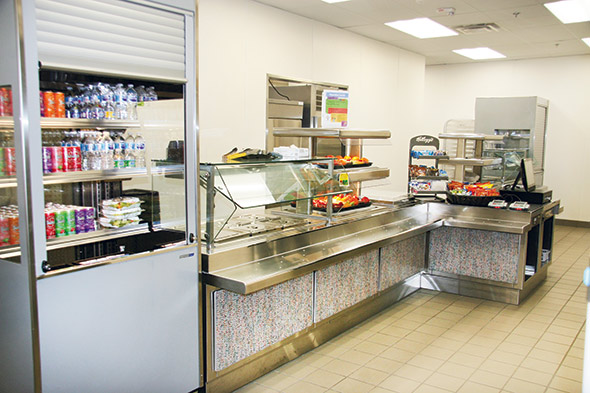Customers’ experience at service lines contributes greatly to their overall dining satisfaction. For staff members, efficiency takes priority in a service line. Their experience in how well the line runs affects their morale and, in turn, how well they interact with customers. Layout and equipment selection contribute to all of the above.
Making decisions about a service line’s length, layout and flow must include the menu mix, says Beth Kuczera, president, Equipment Dynamics Inc., Chicago. Of course, menu changes may happen along the way and the design must include flexibility to accommodate changes, but she feels starting with a solid menu heads off many future complications.
 The service line at Coppell High’s Freshman Campus uses pans slightly smaller than standard size to hold food, which means food rotates into the line more frequently, keeping everything fresh. Photo by Lloyd Hartsfield, CounterCraft
The service line at Coppell High’s Freshman Campus uses pans slightly smaller than standard size to hold food, which means food rotates into the line more frequently, keeping everything fresh. Photo by Lloyd Hartsfield, CounterCraft
Common decisions after menu include determining the time required for customers to enter the line and receive their food, how staff will transport food from the points of preparation to the service line and how much cold, hot and ambient storage will be necessary near the service line. Add to the list figuring out how much of the menu preparation will be visible to customers, which service styles — self-serve, display cooking or a combination of the two — the line will feature, how much interaction staff will have with customers and how many staff members the facility will require to fill the anticipated volume.
Design decisions become part art, part science when balancing operational efficiencies and customer experience. For example, an extensive menu that requires display of many ingredients may appear visually congested and require so much customer and staff decision-making time that speed of service slows. In that case, cutting back on ingredients would allow customers to move continuously through the line.
These kinds of decisions influence the number of service lines required. “If you have one long counter without breaks, customers may become confused and won’t know where to start and stop on the line,” says Christine Guyott, FCSI, RD, principal, Rippe Associates in Minneapolis.
Service Line Structure
The placement of the ingredients that cooks use to prepare menu items remains crucial to a service line’s efficiency. The fewer steps employees take as they work the back of the service line, the more efficient the operation.
At Coppell High’s Freshman Campus in Coppell, Texas, staff working in the back-of-the-house kitchen that sits adjacent to the service line area place prepared menu items into pass-thru refrigerators and heated cabinets so staff working on the service line can easily access them before placing them on the line. The service line uses pans slightly smaller than standard size to hold food, which means food rotates into the line more frequently, keeping everything fresh.
Positioning refrigeration behind the service lines at Jackson Public Schools in Jackson, Miss., allows staff to easily replenish menu items as needed during meal periods. And, at Jefferson County (Jeffco) Public Schools in Colorado, staff in the back-of-the-house kitchen at Three Creeks K-8 School place menu items into pass-thru holding cabinets with glass doors that service line staff access easily.
Organization of ingredients on the service line also impacts how well it flows. Giving ingredients specific, designated locations and displaying them in order of assembly help staff stay organized and move quickly. Leaving enough space between containers holding ingredients and having flat surfaces that staff can easily clean between containers represents another best practice that supports good workflow.
Though undercounter drawers allow cooks to have easy access to ingredients throughout production, many consultants and operators prefer more ergonomic countertop refrigerated rails and displays. Selecting the right refrigerated rails, for instance, can have an enormous effect on efficiency. These come in many sizes and shapes.
In addition to considering the amount of storage and display space for food at a service line, designer and consultants take into consideration storage space for smallwares and packaging. “If we don’t have a lot of countertop space, we’ll put serviceware in front of the serving counter,” Guyott says.
Equipment Considerations
An increasingly large number of service lines today feature induction and ventless equipment to eliminate the need for a full canopy hood. In addition, placing high-speed ovens and toasters close to staff working at service lines minimizes steps they must take to complete orders.
Selecting equipment that accommodates a changing menu is another critical component of the design process. .
The equipment package should also factor in provisions for drains on hot wells. “If you have the steam component, you must have the drains,” says Joe Ferri, DMR, CFSP, chief operating officer of Pecinka Ferri Associates, Fairfield, N.J.
At Jeffco schools, the lines contain dual-temperature food wells and serving shelves that can switch from hot to cold as menu items dictate. “We also wanted food wells that automatically fill and drain easily and efficiently,” says Beth Wallace, MBA, SNS, Jeffco executive director, Food and Nutrition Services. “We had to add drains to ensure proper functioning of the wells.”
 Students at Three Creeks K-8 in Jefferson County Public Schools help themselves to beverages and salads in an upright merchandiser before they move along the service line to entrees, fruits and vegetables, and snacks. Photo courtesy of Jeffco Public Schools Food and Nutrition Services
Students at Three Creeks K-8 in Jefferson County Public Schools help themselves to beverages and salads in an upright merchandiser before they move along the service line to entrees, fruits and vegetables, and snacks. Photo courtesy of Jeffco Public Schools Food and Nutrition Services
Approximating the kilowatt power necessary on a service line is crucial. “Many pieces of equipment are more energy efficient than they were in the past, but estimating the power needed is important,” Ferri says. “That determines how much ventilation is needed for compressors that power the equipment.”
Equipment also must be prewired before installation. “We’ve found that the best approach is to have the factory prewire the serving counter and we specify a one-point connection to the load center, so power is brought to one location,” says Thomas Galvin, FCSI, president, Galvin Design Group Inc., Winter Garden, Fla. “It may not save money, but it saves time in the construction schedule.”
As service lines continue to become more sophisticated and attractive in all types of foodservice operations, nothing serves as a substitute for planning ahead before designing and installing. Building in flexibility also becomes crucial to accommodate changes in menus to meet the ever-fickle customers.




